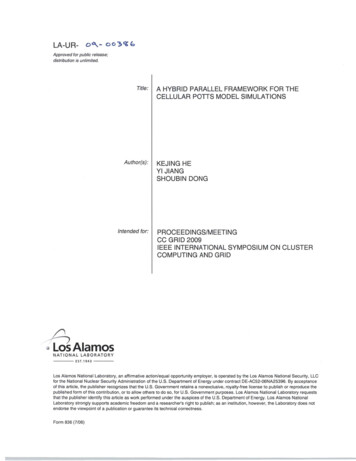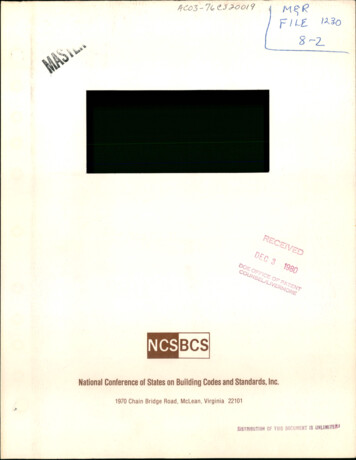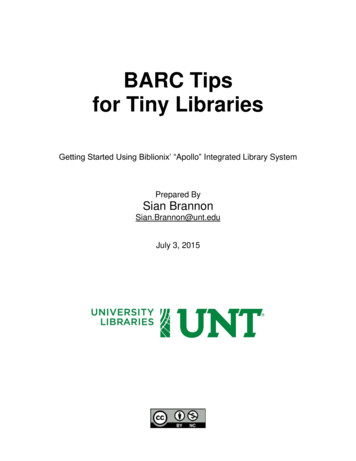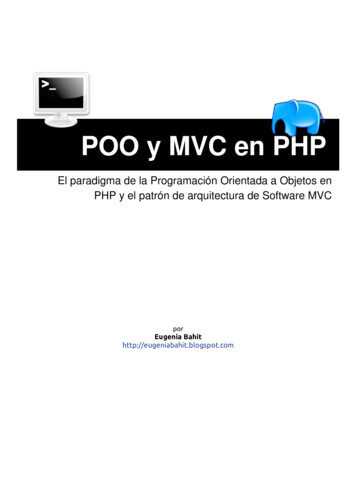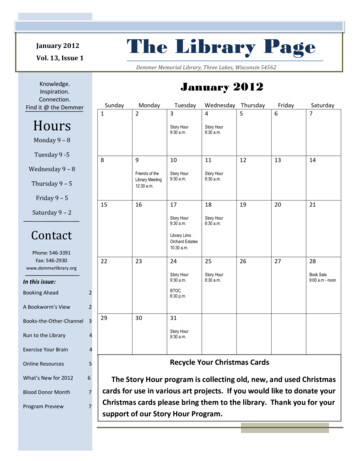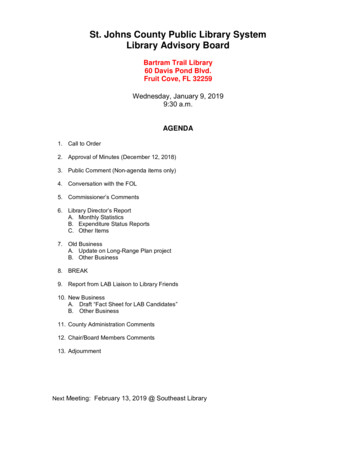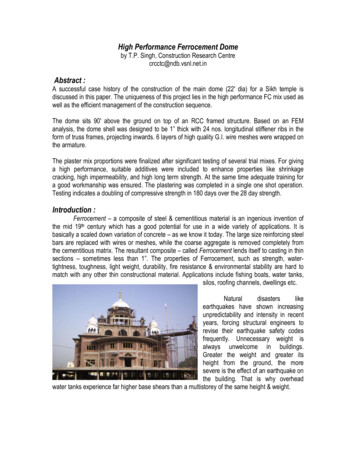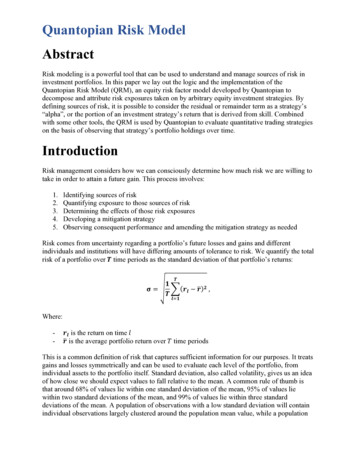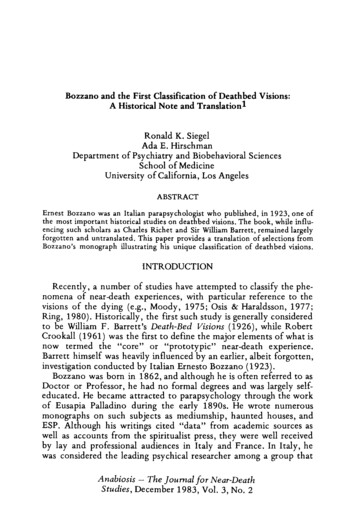
Transcription
Bozzano and the First Classification of Deathbed Visions:A Historical Note and Translation1Ronald K. SiegelAda E. HirschmanDepartment of Psychiatry and Biobehavioral SciencesSchool of MedicineUniversity of California, Los AngelesABSTRACTErnest Bozzano was an Italian parapsychologist who published, in 1923, one ofthe most important historical studies on deathbed visions. The book, while influencing such scholars as Charles Richet and Sir William Barrett, remained largelyforgotten and untranslated. This paper provides a translation of selections fromBozzano's monograph illustrating his unique classification of deathbed visions.INTRODUCTIONRecently, a number of studies have attempted to classify the phenomena of near-death experiences, with particular reference to thevisions of the dying (e.g., Moody, 1975; Osis & Haraldsson, 1977;Ring, 1980). Historically, the first such study is generally consideredto be William F. Barrett's Death-Bed Visions (1926), while RobertCrookall (1961) was the first to define the major elements of what isnow termed the "core" or "prototypic" near-death experience.Barrett himself was heavily influenced by an earlier, albeit forgotten,investigation conducted by Italian Ernesto Bozzano (1923).Bozzano was born in 1862, and although he is often referred to asDoctor or Professor, he had no formal degrees and was largely selfeducated. He became attracted to parapsychology through the workof Eusapia Palladino during the early 1890s. He wrote numerousmonographs on such subjects as mediumship, haunted houses, andESP. Although his writings cited "data" from academic sources aswell as accounts from the spiritualist press, they were well receivedby lay and professional audiences in Italy and France. In Italy, hewas considered the leading psychical researcher among a group thatAnabiosis - The Journalfor Near-DeathStudies, December 1983, Vol. 3, No. 2
196Anabiosis-The Journal for Near-Death Studiesincluded Pictet and Schiaparelli (Reyes, 1970). He had only minimalinfluence on British and American scholars since his only books tobe translated into English were three minor works. Several of hispapers appeared in the English edition of a French journal, Annals ofPsychical Science, between 1905 and 1910 (Christopher, 1979). Thefew case studies mentioned in these papers were nonetheless cited bynumerous subsequent investigators (Osborn, 1974).Bozzano contributed regularly to a number of spiritualist publications (e.g., Luce e Ombre, La Revue Metapsychique, and La RevueSpirite) and soon became the chief spokesman or the spiritualisttheory that life survived death. The anti-survivalists at the turn of thecentury were headed by Charles Richet, who was eventually converted to the survival theory by Bozzano. The source of that conversion was a monograph (1923) appearing in French as PhenomenesPsychiques au Moment de la Mort. The date of the original Italianedition is unknown, but references cited in the book include journalarticles from 1921. It is important to note that Bozzano's first paperon deathbed visions appeared in the July 1906 issue of Revue duMonde Invisible.Bozzano sent a copy of this book to Richet, who wrote back thathe found Bozzano's discussions and case studies on deathbed visionsto be explainable only within the framework of the survival theory.In the opinion of parapsychology scholar D. Scott Rogo (personalcommunication, 1983), Bozzano's book represents one of the threemost important historical studies on deathbed visions, the two othersbeing Barrett (1926) and Hyslop (1918). According to Rogo (personalcommunication, 1983), "Barrett was greatly influenced by Bozzano,[who] helped him to formulate some of his own views about deathbed visions. In fact, he had annotated his copy of the monograph andwas going to write more specifically on Bozzano's views, and hissupport of them, but died before writing these discussions for hisbook." Barrett's book, minus these notes on Bozzano, was publishedposthumously in 1926.We have recently obtained a copy of Phenomenes from a rare-bookdealer in Paris. The book's 260 pages are divided into three parts:Part I, "Concerning apparitions of the dead at the deathbed" (113pages); Part II, "Phenomenon of 'telekinesis' in connection with theevents of death" (66 pages); Part III, "Transcendental Music" (81pages). In Part I, Bozzano classifies deathbed visions into six categories of phenomena and cites numerous case examples of each. Heconsidered the first two categories of primary importance and devotedmore than half of Part I to a discussion of these cases. The remaining
Bozzano and deathbed visions197categories were given minor attention. Selections from his classification system are given below.FIRST CATEGORY"Cases in which the apparitions of the deceased appearsolely to thedying person and relate to persons he knew were dead. [24 cases]"These are the sorts of manifestations that occur most frequentlyin the present casuistry; we perceive that they are also the leastinteresting from a scientific point of view. Given the very vivid stateof emotion in which the dying person, who is still conscious, findshimself, and given, also, the hyperaesthesia of the cortical centers,and the more or less morbid conditions in which they are functioning;and, finally, given the inevitable bent of thought ofthe dying personwho can only turn with supreme agony toward the dear and withdrawn ones, and toward those who have preceded him to the grave,one can easily conceive that all this frequently determines the phenomena of subjective hallucination."Despite this, scientific research methods require us to note thatin the cases of apparitions of the dead appearing at the deathbed, wemeet a circumstance that cannot be easily explained by the hallucinatory hypothesis; and that is that if the thoughts ardently turned toloved ones were the determining cause of the phenomena in question,the dying person rather than submit solely to hallucinations aboutthe deceased - sometimes deceased forgotten by the patient - shouldmore frequently still be the subject of hallucinations portending toliving persons to whom he is closely attached - which does nothappen" (pp. 4-5).SECOND CATEGORY"Cases in which the apparitions of the deceased are still perceivedonly by the dying person, but refer to persons whom he did notknow were dead. [6 cases]"The instances belonging to this category are divided into twodistinct classes. The first concerns cases in which the attendantshad knowledge of the death of the person who will be subjectivelyappearing to the patient who is ignorant of the fact of the death; thesecond refers to cases in which the patient and the attendants areequally unaware of the fact in question. In both circumstances one
198Anabiosis-The Journal for Near-Death Studiesarrives again at explaining the facts by the hallucinatory hypothesiscombined with telepathy. In the first instance, it suffices to assume aphenomenon of unconscious telepathic transmission on the part ofthe attendants; in the second, one must have recourse to telepathictransmission at a distance" (p. 42).THIRD CATEGORY"Cases in which other people gathered about the dying person perceive the same phantoms that he does. [8 cases]"This group of cases, with a collective perception of the samephantom, presents a great deal of theoretical interest, where onearrives once again at the hypothesis of telepathic transmission ofthought although one does not find oneself facing any specialcircumstances. In effect, the coincidence of the apparition viewed bythird persons, collectively with the dying one, can be attributed tothe fact that the latter serves as the transmitting agent of an elaborateform of hallucination in the brain, and that is in the case of simultaneous visualization; if, on the other hand, the phantom is seen bythe attendants and the dying person at different times and places,then that fact acquires a great theoretical significance in the sense ofspiritualistic interpretation" (p. 53).FOURTH CATEGORY"Cases of apparitions at the deathbed coinciding with predictionsor similar confirmations obtained by means of mediums. [7 cases]"In this case, one can always suppose that an apparition at thedeathbed, predicted or affirmed by a medium, takes root in a telepathic rapport being produced between the subconscious of themedium and that of the patient, or between that of the medium andthe patient, the medium and the physicians" (p. 70).FIFTH CATEGORY"Cases in which the intimates of the dying person are the only onesto see the phantoms of the dead. [ 9 cases]"Cases of this nature are pretty rare, and that is natural as, in theorder of probabilities, we are aware that most manifestations appear
Bozzano and deathbed visions199to the dying persons alone, and that apparitions appearing to thepatient and the attendants together are relatively rare and rarerstill are those perceived by the attendants alone."Concerning the theoretical interpretation of these facts and froman absolutely scientific point of view, they are liable to be explainedby telepathic hypothesis, supposing a phenomenon of transmissionof thought from the dying person - under special circumstances"(pp. 85-86).SIXTH CATEGORY"Examples of apparitions of the dead, appearing a short time aftera death and observed in the same house where the corpse lies. [ 1 case]"Everyone can readily understand the great theoretical importanceof the cases which now concern us. If one could collect a sufficientnumber of examples, they would make an important contribution infavor of the spiritualist thesis. That possibility is, however, still remote;the facts in question are the rarest ones, which is not surprising,given the extraordinary conditions which are necessary to producethem" (pp. 102-104).CONCLUSIONS"With this work on the phenomena 'of apparitions of the deceasedat the deathbed,' I have applied myself to a hard task, and theconclusions to which I have arrived can be summarized in the following terms:"According to the methods of analysis compared between thetelepathic phenomena and the 'visions of the dying,' it appears toindicate that when these visions are perceived solely by the attendants,or else by the attendants and the dying person, one must exclude inprinciple that the event is produced through telepathic communicationfrom the thoughts of the dying person. It therefore follows logicallythat the visions perceived solely by the dying person cannot have adifferent origin from the others, and that, consequently - always asa general rule - the same source must be attributed to the entiregroup of phenomena. As to the nature of this source, one can arguethe case of collective visions, or the identity of a phantom that cannotbe explained by transmission of hallucinatory thoughts of the dyingone returning by necessity the worth of the proof. It is what alsoproves the kinds of phenomenal manifestations too often irrecon-
Anabiosis-The Journalfor Near-Death Studies200cilable with the hallucinatory hypothesis. In other words: accordingto the scientific study of the manifestations in question, one isbrought to the conclusionthat the hallucinatory and telepathichallucinatory hypotheses are insufficient to explain all the facts,and that, by contrast, the spiritualist hypothesis lends itself to thismost admirably" (pp. 112-113).COMMENTPrior to Bozzano's classification scheme, investigators of psychicphenomena had published numerous cases of apparitions occurringat death, but none had concentrated on the deathbed visions per se.And none had attempted to group these seemingly complex and idiosyncratic phenomena into cohesive and well-defined categories.Bozzano accomplished all of that. And while his interpretations wereheavily influenced by spiritualist and psychic thinking, he entertainedalternative explanations such as the hallucination hypothesis.In the beginning of the book, Bozzano remarked that he was nottrying to prove a thesis but to recall a number of incidents that hada limited scientific value but, when taken together, had a greater value.The collective value of the cases convinced Bozzano, Richet, andothers that the survival theory was the most salient explanation fordeathbed visions. Bozzano's arguments may be far from compelling,but we can be pleased that the soul of his work, if not his body, hassurvived.NOTE1.The authors thank D. Scott Rogo for supplying helpful information on the life and works of Ernest Bozzano.REFERENCESBarrett, W.F. Death-Bed Visions. London: Methuen, 1926.Bozzano, E. Phenomenes Psychiques au Moment de la Mort. Paris:Editions de la B.P.S., 1923.Christopher, M. Search for the Soul. New York: Crowell, 1979.Crookall, R. The Supreme Adventure. London: James Clarke, 1961.Hyslop, J.H. Visions of the dying. Journal of the American Societyfor Psychical Research, 1918, 12, 585-646.Moody, R. Life After Life. Covington, Ga: Mockingbird, 1975.Osborn, A.W. The Supernatural. New York: Harper & Row, 1974.(originally published 1937)
Bozzano and deathbed visions201Osis, K., and Haraldsson, E. At the Hour of Death. New York:Avon, 1977.Reyes, B.F. Scientific Evidence of the Existence of the Soul.Wheaton, Ill.: The Theosophical Publishing House, 1970.(originally published 1949)Ring, K. Life at Death. New York: Coward, McCann and Geoghegan,1980.Requests for reprints to:R.K. Siegel, Ph.D.P.O.B. 84358VA BranchLos Angeles, California 90073
Doctor or Professor, he had no formal degrees and was largely self educated. He became attracted to parapsychology through the work of Eusapia Palladino during the early 1890s. He wrote numerous monographs
